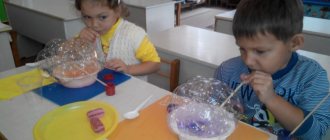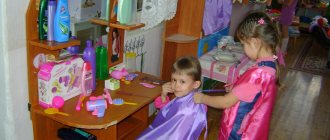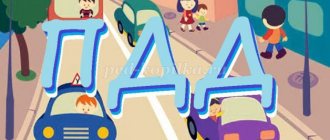Table: card index of topics on labor activity in the senior group of preschool educational institutions
| Author | Savina P.I. | |||
| Type of labor | Subject | Tasks | Examples of work | Note |
| Household labor | "Cleaning up closets and shelves" |
| Try to encourage your children to clear out bookshelves or organize toy cabinets. | Tell the kids a story about slobs and explain that they shouldn’t do that. |
| "Neatly made beds" |
| After quiet time, talk to your children about the importance of keeping their bed tidy. Explain to them in a playful or fairy-tale way about the germs that can appear in the bed if it is not made. | You can cut out figures of microbes from cardboard and place them on the bed of a child who has not made it. | |
| Labor in nature | "Water the plants" |
| Invite the children to take care of the indoor flowers that are in the group. If there are no such flowers, then you can take the children outside and talk about watering plants using the example of street bushes, grass or flower beds. | You can imagine the watering can as a “cloud”. Thanks to this, you will not only show children the principle of working with plants, but also explain what rain is. |
| “Wet wiping of leaves of large-leaved plants” |
| Teach children about the dust that flies in the air and settles on plants. Explain to them how to carefully wipe the leaves. | Try using not only rags, but also damp sponges. They absorb liquid much better and stay wet. They are then easy to dry. | |
| Teamwork | “General work on the corner” | Learn to create collective crafts and figurines to decorate their “children’s corner.” | Use several types of creative materials: paints, pencils, plasticine, cardboard, etc. The main task of the teacher, in addition to instructing and explaining to children how to work, is to control all actions with dangerous tools. | Encourage children to paint with their fingers. You can help color their hands and put them on paper. |
| "Joint and general games" |
| Try playing the group game “Tea-Tea to the Rescue.” The player who will be the “driver” is selected. He runs after other guys and catches them. The child he touches becomes “bewitched.” Another player can touch the “bewitched” and free him. The game ends when all players become "bewitched". | Playing games with sports equipment such as balls or jump ropes is useful not only in terms of developing social skills, but also improves physical abilities. | |
| Self-service | “Independent search for answers to the question posed” |
| Ask your child a question like: “What was the name of the chicken that laid the egg?” Ask your child to find the answer in the story itself. This will prepare him well for future assignments at school. | Question options: “Where is Koshchei’s life hidden?”, “How many knights come out of the sea in Pushkin’s fairy tale?”, “Who is the mermaid?” |
| "Self-care" |
| Provide your child with a clothes brush and talk about how to properly clean clothes. Explain why this should be done (“to look neat”). | Try talking about how to keep your clothes in order so that you have to clean them as little as possible. | |
| Duty | "Duty in the dining room" |
| Select a few children and bring them to the dining room. Then tell them how to set the table and arrange the plates. After this, you can begin practical work and allow the children to do everything on their own. | Try to come up with some little incentives for those guys who were on duty especially well. |
| "Street duty" |
| Give a few kids brooms and offer to sweep the leaves off the paths if it's autumn. In winter, you can ask for help removing small piles of snow using shovels. And in the spring you can show the children how to water the flowers in the flower beds. | Always make sure that your child is assigned only work that he is definitely able to do. | |
| Handmade and artistic work | "Creating Crafts" |
| Try to gather a small group of children and make a plasticine craft with them. For example, the “Hedgehog” craft:
| This type of work allows the teacher to get to know the children better. |
| "Artwork" |
| Give children coloring books and provide pencils. | Try showing your children a few drawings that you can draw yourself. | |
Perspective plan for manual labor
Manual labor in the senior group is evenly distributed throughout the entire academic year. According to the Federal State Educational Standard, classes should be held twice a month to teach creative work and develop innovative thinking. Every two weeks, a lesson is organized where children are asked to familiarize themselves with natural materials and imagine what can be made from them.
Hedgehog from a cone
Important! Time is allotted, about 5 minutes, so that the children can fantasize about what kind of animals they will get from the proposed items. The teacher, with leading questions, helps the children guess who they will create.
Indicative plan for the year for the senior group of preschool educational institutions
September:
- There are walnut shells and plasticine on the tables in front of the children. During the lesson, the children learn to create a turtle from the set provided. The teacher introduces the way and duration of life, habitats and diet. Children, based on the size of the shell, add paws, a head and a tail from plasticine.
- On the tables in front of the children are cones, leaves, twigs and plasticine. The teacher reminds about migratory birds and their habitats. Children use the proposed natural material and plasticine to create a bird, similar to the one demonstrated by the teacher.
October:
- Children are offered natural material from seeds, leaves, twigs, and fallen alder catkins. In addition, glue and a sheet of paper are given. The child’s task is to create a proportional panel, placing the composition mainly in the middle of the sheet.
- The children are provided with the most expanded range of natural materials so that they can choose the necessary components for working on a free topic.
November:
- Classes are aimed at developing fine motor skills and improving scissor skills. The teacher shows how to create a mushroom from two sheets of paper, scissors and glue. To give the result a colorful look, make the cap red, after gluing white circles on it to create the most memorable mushroom - the fly agaric.
- Using scissors and paper, children need to cut out pieces from colored paper according to a template, which will then be used to glue the cockerel and chicken together. An addition to labor is the opportunity to use the result of labor in a staged game.
Children work
December:
- On the eve of the magical holiday, children are working on creating garlands and other Christmas tree decorations. The materials and tools they have are colored paper, scissors, glue, templates, pencil, brush.
- The teacher teaches children to cut out future Christmas tree decorations from templates and paper folded in half, by tracing the shapes with a simple pencil to determine the cut line. In addition, glue and thread or ribbons are provided, with which the resulting toys will be attached to the Christmas tree.
Speech development as a factor in the successful development of a child
January:
- Children learn to make a truck using boxes and spools. The teacher reminds about the benefits of freight transport. Children practice reproducing the shape of car parts in a craft project. The tools used are glue and scissors.
- The lesson is aimed at improving the ability to paste objects with material or paper. The crafts used are train cars, which children create from cardboard boxes, cover with decorative coverings, and connect to each other. A new tool is introduced - an awl, in addition to the already familiar scissors, pencil and glue with a brush.
February:
- The final winter month is dedicated to seasonal crafts - a snowman and a Christmas tree. Children need to cut out parts of a snowman from white paper according to a template, and tiers of a Christmas tree from green paper.
- On the eve of Defender of the Fatherland Day, children develop their imagination on the theme: “Postcard for Dad.” Without templates, they cut out parts, select colors, and glue the composition onto paper.
March:
- Children are invited to create a holiday craft for their mother from scrap material, colored paper, glue and scissors. The result should be a gift vase.
- The teacher continues to teach children how to work with foam rubber, offers to decorate it using colored cardboard, fabric, glue and scissors and turn it into a pincushion.
Vase for mom
April:
- Children continue to improve in working with templates - tracing and cutting along the lines. The children string the resulting figures onto wire or tape to make a baby rattle.
- The lesson is aimed at didactic work with a sheet of paper, recalling geometric shapes - by folding the given sheet of paper several times, children learn to make paper fish, which they will attach to paper that imitates the glass of an aquarium.
May:
- The children master the skill of cutting out small parts by eye to decorate a self-made cone or cylinder. The result is the use of imagination to create your own jewelry.
- The lesson is aimed at consolidating knowledge in geometry. The material used is colored paper in the shape of a square, from which children create new shapes by folding, twisting and bending.
Attention! Children are taught to work with sharp instruments after instruction from the teacher and under his close supervision.
Diagnostics of the results of labor activity in the senior group of preschool educational institutions
The diagnostic card helps the teacher evaluate the results of working with children and sum up the results for the six months. In addition, with the help of this document, the teacher systematizes information and determines what each child has achieved and what he cannot cope with.
The diagnostic card records all types of work activities of senior group students.
Table: example of a diagnostic card
| Author | Savina P.I. | ||
| Development indicators | Actions and tasks | Positive result (the child copes with the task) | Negative result (child fails to complete the task) |
| Motivation | Have a desire to participate in work activities | ||
| Gain the skill of taking a proactive approach to business | |||
| Views of adults' work | Desire to provide all possible assistance to adults | ||
| Attitude to work | Desire to learn about future professions | ||
| Respect for other people's work | |||
| Careful attitude towards the results of your work | |||
| The working process | Careful handling of materials | ||
| Use the most productive work methods | |||
| Finish what you started | |||
| Teamwork | Friendliness and ability to work in a team | ||
| Develop communication skills | |||
| Mandatory | Competently evaluate the results of work | ||
| Have the habit of taking orders responsibly | |||
| Labor in nature | Appreciate and respect nature and its gifts | ||
| Have basic plant care skills | |||
| Know how to plant seeds | |||
| Self-service | Be able to take care of your appearance | ||
| Correct your hairstyle and hair | |||
| Manual labor | Know how to glue cardboard and paper | ||
| Strengthen skills in working with scissors | |||
| Duty | Possess basic table setting skills | ||
| Develop independence | |||
| Household work | Know how to wash things | ||
| Making the bed after sleep | |||
Labor activity is the most important aspect of preschoolers’ education. Children develop the skills necessary for future life in society. The teacher should try to help and guide the child, and instill a love of work. The main thing is not to do all the work for the pupils and allow them to express themselves so that they can fully develop their abilities and potential.
Card file of GCD for manual labor
Direct educational activities should be aimed not only at labor skills, the development of motor skills and the eye, but also at the knowledge of collective work. Some guys are able to complete the task faster and more deftly, while others have difficulties. When a child sitting next to him helps a neighbor, the teacher does not interfere, but observes how the children learn to help each other in their work.
Diagnostics of the thinking of preschool children
GCD includes paired tasks in which the teacher distributes the children so that there is no pair with two weak children, so that there is not a single team in which the children cannot help each other.
Important! After completing work on each craft, the children examine the results of other people’s work in order to praise the creators.
All educational activities contain a list of classes built on several areas:
- the ability to create images and objects from cut out paper strips;
- use waste material to make a toy or craft from it;
- cut out geometric shapes using the proposed template, and also without it;
- application of skills of fastening parts from different materials to each other - plasticine, glue, tape,
- practice paper folding techniques using origami patterns;
- perfecting one of the most difficult skills for children - rolling paper and securing its edges in order to get a cylinder, adding a bottom and a lid.
Mutual assistance at work
Outline of manual labor
Manual labor in the senior group, described by the card index, additionally trains abilities for group activities. The distribution of lesson topics by season allows us to closely connect work with nature. But non-seasonal work should also be carried out in preschool educational institutions, aimed at limitless flights of imagination. One of the recommended topics is space.
Purpose of the lesson
The lesson is aimed at expanding knowledge about space, planets and weightlessness. Children construct a starship from the proposed waste, natural and stationery materials.
Progress of the lesson
The teacher talks with students about space. They remember the structure of the solar system, the reasons for the change of day and night, as well as the alternation of autumn, winter, spring and summer. After completing the oral work, the children are asked to create a spaceship.
Craft ideas
The basis is most often taken on a large cardboard box that can fit several astronauts. Children use cut-off plastic bottles to construct rocket nozzles and imitate fire with loose bast wool or paper strips painted red. The ship's hull is decorated with carved stars, inscriptions and drawings. If the size of the box allows, chairs are placed in it.
Self-analysis of the lesson
Manual labor in a team teaches children to work together. The teacher watches how the children create something together, consult and discuss the details of the future craft.
Interesting! During such activities, disputes often arise regarding the real prototypes of their crafts; for example, often while working on a bird, children begin to argue about which birds are migratory and which are not. There is a heated discussion and learning about the world at the same time.
Handmade crafts that were presented to parents in honor of a particular holiday develop a sense of responsibility and thrift in the child. The work put into a gift increases its value.



